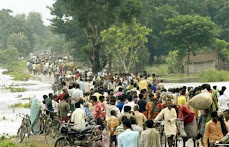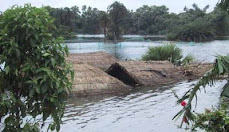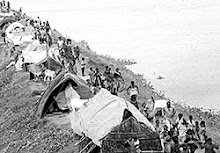'Bihar is destined to die. Nobody counts us'
http://specials.rediff.com/news/2008/sep/02sli1.htm
"Who listens to us? Nobody. Biharis keep dying due to floods, but nation doesn't take notice of them. I know so many families in north Bihar who have lost their homes 14 times due to floods after Independence. Then, so what? Does anybody care for them? Do you know last year 960 people died due to floods in North Bihar? Nobody reads news from Bihar. That is Dinesh Kumar Mishra.
Environmentalist and engineer from IIT,62-year-old Mishra adds poignantly, "Bihar is destined to die. Nobody counts us."
Mishra is also the convenor of Barh Mukti Abhiyan, which tries to organise communities in Bihar's flood-prone areas. It already has, he says, 700 rural groups of "flood historians".
"The coming 30 days will be chaotic in north Bihar because till October you cannot repair the embankment fully. Second, even now, nobody knows how many people are trapped in flooded areas waiting for rescue team. It is very important that rescue teams reach out to all the people in flooded areas soon," says Mishra.
"Until, rescue teams penetrate villages, nobody will be able to guess correctly the real situation.People have lost monsoon crop because rivers have submerged the farms. Two, they will lose subsequent crops too because Kosi river has spread sand all over area. It will take almost a decade to get rid of this deposit of sand fully. In other words, floods mean that more and more poor people will have to migrate because there will be no employment on farms," says Mishra.
"It is the goodness of the poor that they don't commit suicides," Mishra adds..
He says there is an urgent need of food, medicines, drinking water and fodder for animals at various relief camps in Bihar. The displaced, he says, will have to be fed for two months or so.
While giving a grim picture of stark reality of lakhs of marooned families in north Bihar, he says, "When flood sweeps any village, the dignity of family members takes a beating.Har admi har admi se bepurdah ho jata hai. (People who are marooned lose shame.) Everything is done in public. You imagine the plight of family taking refuge at higher places. They do everything in open. Even when a women delivers baby she can't ask for privacy."
Mishra's mission is to understand the floods across India, particularly of rivers of Bihar, mainly Kosi. He says, "Nadion se mohabbat ho gayi hai." (I am besotted with rivers.)
The engineer uses his knowledge to link people with government and policy makers.
Talking about the current situation, he says, "The government claims that 56 people have died, but in Nepal at Kushaha (where embankment got breached ) eyewitnesses say 100 people died there only."
Mishra, who has a deep knowledge of floods, says, "Its difficult to figure out the actual number of deaths due to floods. During floods, many die due to snake bites, house collapse and boat capsizes. Unless the body is found and identified, government doesn't declare a person dead due to floods. For so many years, we have seen that at gates of Farrakka barrage over Ganga, dead bodies are found sometimes after floods in north Bihar. Kosi meets Ganga and there is no obstacle to flow of Ganga up to Farakka barrage in West Bengal. One never knows exactly how many people have died in floods in Bihar."
He says floods are harsh realities. He is fighting for the policy of prevention of flood and relief measures. Since 1984, Mishra has been advocating decentralized ways of coping with floods. He travels across India to educate people, living on banks of rivers, about traditional flood management systems. He reminds people that they have cultural ownership over rivers and any preventive or relief measures of floods should be people-centric.Mishra, so far unsuccessfully, is trying to create a new paradigm of flood control.
Working for the rights of victims of floods, he has written a moving story of river Kosi Dui Patan Ke Beech.
Mishra says in 1984 he was asked to prepare a report by a friend on the floods at Hempur village in Saharsha. Since then he had been witnessing year after year unbelievable human trauma due to floods in North Bihar and elsewhere.
That year, too, the embankment on the Kosi had breached and more than 450,000 people were stranded. Neither government nor political leaders had any idea about the floods.
He says without Nepal giving site to build a dam, India can not move further. The problem is that Kosi river has too big a catchment area and that will face water logging. Nepal will try to save its side and its people in case of heavy rains and will keep control of gates in it's hands.Even now, around 10 lakh people live between river and the embankment area.
The slit of Kosi river is such that a big dam may not be a final solution, he says.
Even today, around 9 lakh hectares of land of North Bihar remains flooded every year.
More than 80 lakh people get affected even in normal years when heavy rains raises water levels.
He told rediff.com, 'Biharis are uncared for. Biharis who sit in Parliament are also not taken seriously.When floods take away everything, more and more Biharis end up on the footpaths of Mumbai or Delhi or Gujarat."
When they are pushed away from there,they will come back to face another flood.
Mishra has studied the micro and macro aspects of floods of Bihar.
To get a thorough knowledge, he parked himself in the National Library of Calcutta for a year. Mishra has read debates over taming of the Kosi since British times.
He says, " Kosi's waters are not giving us as much problems as the slit that it carries. Because of slit, bed level increases and along with it there is need to raise the heights of embankments."
But, that hasn't happened. This year even the repairs work could not happen. He says normally around February technical advisory committee meets.The estimates are made, tenders are announced and budget gets passed. But somehow these didn't happen this time, he alleges.
For the last few years, has tried to understand why the Centre and state governments back out in finding permanent solutions of flooding rivers of Bihar. His extra-ordinary scholarly studies are available in his first book Barh Se Grast (Those Afflicted by Flood)
Mishra has written books on Mahananda and Kamla rivers, too.
"There is no two opinion that the floods of this year is due to negligence. The repair work of embankments is responsibility of the state government.Sometimes they are able to repair it and sometimes not, he says.
He says in 1963, 1968,1971,1980,1984,1987 and 1991 similar floods have come due to similar breach in embankments of rivers in Bihar.
Mishra says, "Bihar is India's most flood-prone state. According to government figures, in 1952, around 25 lakh hector area in Bihar was flood affected but now, 68.8 lakh hector of land in Bihar is flood-prone. In north Bihar, almost 76 per cent of land is flood-prone."
When asked why TV footage and photographs show such stark poverty of the displaced, he said, "North Bihar is one of the most-densely populated areas. There is too much pressure on land. More people depend on the land then it can sustain."
"What is needed is a drainage commission. We are unable to drain out flood waters. That is our biggest tragedy," Mishra says.
Despite all the destruction over the years, he says, no solution has been found yet.
"Every time some decisive moment comes suddenly nothing moves further," says Mishra.
He argues, 'Probably, there are three factors behind inaction on part of the Central and state governments in taming Kosi. If government decides to build a dam over Kosi, it can be built on the Nepal side only. Nepal will gain through power generation but, it will have only one buyer for it. India will have only one seller. This option of limited market is not encouraging for both sides to spend money on dam. Also, in the operation of dam, power generation project and maintenance of the site there will be too much dependence on Nepal. The huge project will be in entirely on a different land. Third, from point of view ofstrategic defence, it doesn't look like a good idea for government."
Those who wish to help the victims can contact Dinesh Kumar Mishra at the following address:
The Convenor, Barh Mukti Abhiyan
Road No: 6, B Rajiv Nagar
Patna 800024
Bihar.
Mobile:09431303360
E-mail: dkmishra108@gmail.com
NOte: Dr Dinesh Kumar Mishra was a key member of the Fact Finding Mission on Kosi. Mission's report is due for release on 12 September in Delhi.
Historically, floods and their control have never been a big issue in the Ganga-Brahmaputra basin, as it is today. Floods became a major issue after the British occupied India. When they examined the Ganga basin, they believed that if it could be made “flood-free”, they could levy a tax in return for such protection.
Thursday, 11 September 2008
Subscribe to:
Post Comments (Atom)








No comments:
Post a Comment